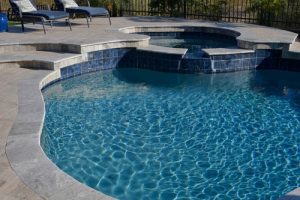
1. Regular Testing and Balancing:
To maintain optimal pool water quality, it is crucial to regularly test the water and balance its chemical levels. This includes monitoring pH levels, chlorine content, alkalinity, calcium hardness, and cyanuric acid. These parameters should be checked at least once a week using reliable test kits or by seeking professional assistance. By keeping the water balanced, you not only prevent the growth of algae and bacteria but also ensure that swimmers don’t encounter any discomfort or health issues.
2. Proper Chlorination:
Chlorine is the most common and effective sanitizer used in swimming pools. It eliminates harmful bacteria, viruses, and other contaminants lurking in the water. However, it’s essential to maintain the appropriate chlorine levels for optimal efficacy. A chlorine residual of 1-3 ppm (parts per million) is generally recommended for residential pools. Too little chlorine can lead to the growth of algae and bacteria, while excess levels can cause skin and eye irritation. Regularly testing and adjusting the chlorine levels will ensure a safe and sanitized swimming environment.
3. Algae Prevention and Treatment:
Algae growth is a constant threat to pool water quality. This unwanted green menace can quickly turn a sparkling pool into a murky mess. To prevent algae growth, it’s advisable to add algaecide to the water on a weekly basis. Algaecides help to inhibit algae growth and keep the water crystal-clear. In case algae still manage to take hold, prompt and targeted treatment is necessary. The type and quantity of algaecide required will depend on the severity of the infestation. Brushing the pool walls and using a pool vacuum regularly will also aid in algae prevention.
4. Regular Filtration and Cleaning:
The pool’s filtration system plays a vital role in maintaining water clarity. The filter traps debris, leaves, dirt, and other particles, preventing them from clouding the water. To ensure efficient filtration, clean or backwash the filter regularly. This can be done on a monthly basis, although the frequency may vary based on pool usage and environmental factors. Additionally, skimming the pool surface and emptying the strainer baskets will help to remove larger debris before it reaches the filter. Regular cleaning and circulation of the pool water will significantly contribute to maintaining its cleanliness.
5. Monitoring pH and Alkalinity:
The pH and alkalinity of the pool water are critical in ensuring swimmer comfort and the efficacy of other chemicals in use. The pH level should be maintained between 7.4 and 7.6, while the alkalinity should be within the range of 80 to 120 ppm. Proper pH levels prevent eye and skin irritation, prevent corrosion of pool equipment, and optimize chlorine’s effectiveness. Alkalinity acts as a buffer, keeping the pH stable. Regularly testing and adjusting these parameters will help to maintain water chemistry balance.
6. Calcium Hardness and Cyanuric Acid Levels:
Calcium hardness affects the pool water’s ability to prevent scaling, corrosion, and cloudiness. The recommended range for calcium hardness is typically between 200 and 400 ppm. If the calcium levels are too low, it can lead to equipment damage, while excessively high levels can cause scale formation. Similarly, cyanuric acid, also known as stabilizer or conditioner, helps to protect chlorine from being quickly degraded by sunlight. The ideal cyanuric acid levels are between 30 and 50 ppm. Regular testing and adjustments are needed to ensure balanced levels of both calcium hardness and cyanuric acid.
Summary:
Maintaining clean and safe pool water quality requires consistent effort and vigilance. By following the best practices outlined in this blog, you can enjoy a pristine, sparkling pool that offers a refreshing and healthy swimming experience. Remember to regularly test and balance your water chemistry, use proper chlorination and algaecide, optimize filtration and cleaning, and monitor and adjust pH, alkalinity, calcium hardness, and cyanuric acid levels. Pool water quality management is not only crucial for your swimming enjoyment but also for the well-being of everyone who takes a dip in your pool.
